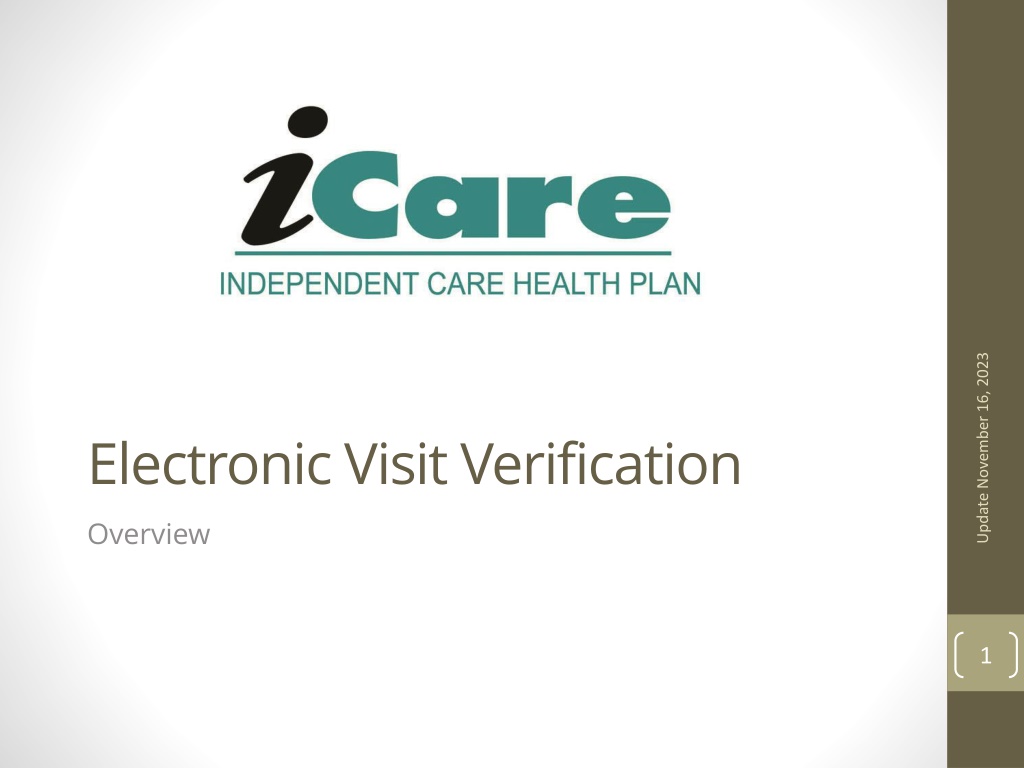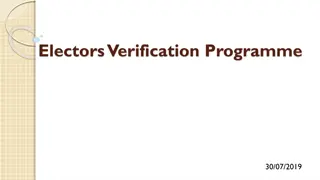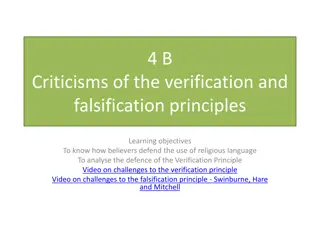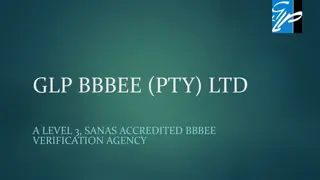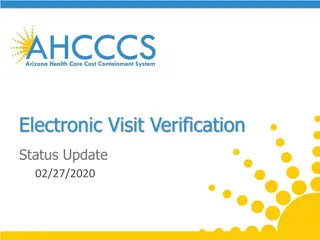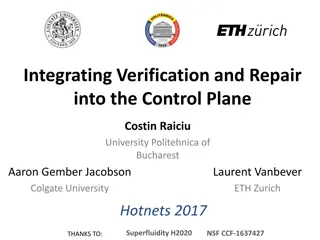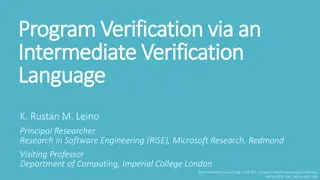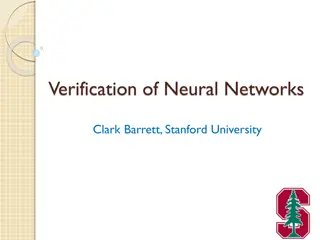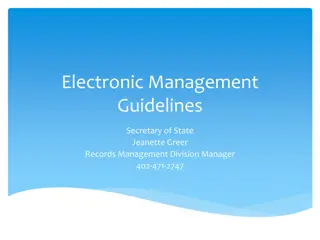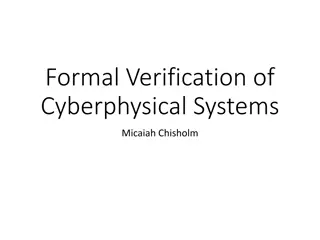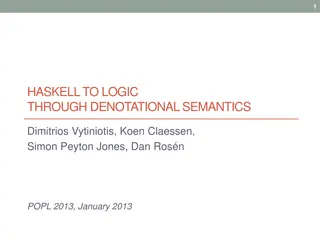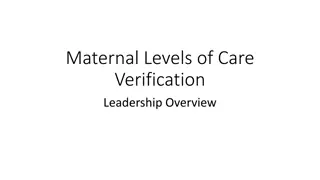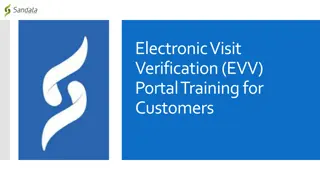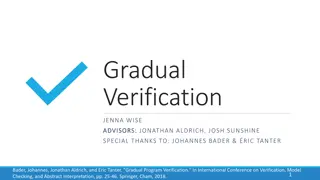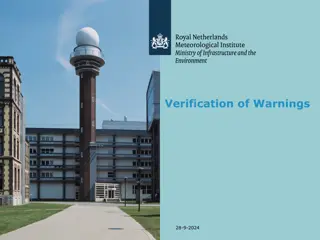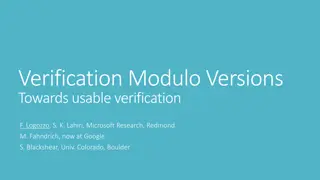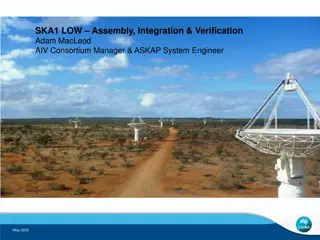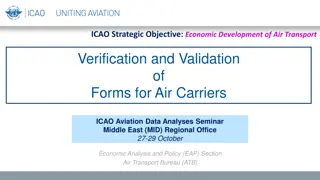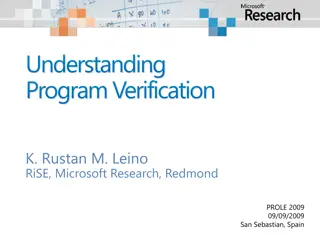Electronic Visit Verification Overview
The Electronic Visit Verification (EVV) system is a requirement under the Federal 21st Century Cures Act for verifying Medicaid-covered Personal Care Services, Supportive Home Care, and Home Health Care. EVV utilizes technology to ensure authorized services are provided, with workers recording details such as service recipients, providers, type of service, location, and timings. Compliance with EVV requirements is essential for Medicaid and BadgerCare Plus programs in Wisconsin. Specific services impacted include Personal Care Services, Supportive Home Care, and more. Workers play a crucial role in accurately documenting service-related information for EVV implementation.
Download Presentation

Please find below an Image/Link to download the presentation.
The content on the website is provided AS IS for your information and personal use only. It may not be sold, licensed, or shared on other websites without obtaining consent from the author. Download presentation by click this link. If you encounter any issues during the download, it is possible that the publisher has removed the file from their server.
E N D
Presentation Transcript
Update November 16, 2023 Electronic Visit Verification Overview 1
Disclaimer: This information is provided in part, as a courtesy from iCare to assist you with claims submission and billing. This does notreplace Forward Health and DHS Guidelines. iCare relies upon Forward Health and DHS for payment rules and regulations for claim submission. Please reference the ForwardHealth Implementation of Electronic Visit Verification for Personal Care and Supportive Home Care Services https://www.forwardhealth.wi.gov/kw/pdf/2020- 31.pdf for additional guidance and ongoing changes iCare contracted Personal Care and Supportive Home Care providers must comply with ForwardHealth EVV requirements, including training. 2
Per Wisconsin Department of Health Services The Federal 21st Century Cures Act requires all states to implement Electronic Visit Verification (EVV) for Medicaid-covered Personal Care Services and Supportive Home Care (PCS & SHC) and Home Health Care Services (HHCS) EVV is a system that uses technology to verify that authorized services are provided. Through EVV, a worker providing Personal Care or Supportive Home Care services sends visit data to an EVV vendor at the beginning and end of each visit using methods such as: a mobile application a home phone (landline or fixed Voice over Internet Protcol [VoIP]) fixed device 3
Per Wisconsin Department of Health Services Cont. Workers using EVV enter information to record Who receives the service Who provides the service What service is provided Where the service is provided The date of the service. The check in and check out times for the service Programs affected Medicaid and BadgerCare Plus (ForwardHealth card) BadgerCare Plus and Medicaid SSI HMOs Family Care and Family Care Partnership IRIS (Include, Respect, I Self-Direct) *IRIS does not apply for HHCS 4
Services Impacted PCS & SHC Personal Care Services T1019 (Personal care services, per 15 minutes, not for an inpatient or resident of a hospital, nursing facility, ICF/MR1 or IMD, part of the individualized plan of treatment) T1020 (Personal care services, per diem, not for an inpatient or resident of a hospital, nursing facility, ICF/MR or IMD, part of the individualized plan of treatment) Supportive Home Care services (Family Care Partnership) S5125 (Attendant care services; per 15 minutes) S5126 (Attendant care services; per diem) 5
Services Impacted HHCS 92507: Treatment of speech, language, voice, communication, and/or auditory processing disorder; per visit 97139: Unlisted therapeutic procedure Occupational therapy; per visit 97799: Unlisted physical medicine/rehabilitation service or procedure Physical therapy; per visit 99504: Home visit for mechanical ventilation care; per hour 99600: Unlisted home visit service or procedure; per visit S9123: Non-vent private duty nursing care in the home by registered nurse; per hour S9124: Non-vent private duty nursing care in the home by licensed practical nurse; per hour T1001: Nursing assessment/evaluation; per visit T1021: Home health aide or certified nurse assistant; per visit T1502: Administration of oral, intramuscular and/or subcutaneous medication by health care agency/ professional; per visit 99509: Nurse supervisory visit; Home visit for assistance with activities of daily living and personal care; per visit 6
PCS & SHC - Hard Launch May 1, 2023 HHCS - Soft Launch January 1, 2024 (Hard Launch TBD) Effective May 1 2023, ForwardHealth and iCare will require PCS & SHC claims to have a matching EVV record; if there is no matching EVV record or KX Modifier, the claim will be denied Effective January 1, 2024 ForwardHealth and iCare will require HHCS claims to have a matching EVV record; claims will not be denied during soft launch. 7
Technology DHS s chosen EVV solution, offered through a vendor called Sandata, may be used by all DHS programs, provider agencies, and program payers. DHS will provide the Sandata EVV system s data collection functionality free of charge to providers and program payers. Provider agencies and program payers will not have to purchase an EVV system if they elect to use the DHS-provided EVV system 8
EVV Data Collection Mobile phone application (mobile visit verification [MVV]): This option allows the worker to record visits using a smart phone or tablet, even when no cellular, satellite, or other data services are available at the service location Landline or fixed VoIP phone (telephonic visit verification [TVV]): This option allows the worker to record visits via a landline or fixed VoIP phone at the service location using a toll-free phone number EVV digital device (fixed visit verification [FVV]): This option allows the worker to record visits with a small electronic device. The device, which is secured to a surface in the member or participant s home, provides a code that links the time and date the services are provided to the client and service location. The visit information is then submitted to the provider agency or program payer via a phone. FVV is the option of last resort and may only be requested if certain criteria are met. Refer to the Fixed Visit Verification section of this Update for more information Note: Alternate EVV systems may employ different data collection methods. Refer to the Alternate EVV Systems section of this Update for more information on alternate EVV 9
Corrections In addition to manually entering visits, administrative users of DHS EVV may correct exceptions for valid EVV data. In the DHS-provided EVV, provider agencies will be able to identify exceptions that are preventing visit data from being validated and log in to the Sandata Provider Agency EVV portal to acknowledge or correct them All corrections to EVV visit information, including those made through an alternate EVV system, require an associated reason code to explain why the EVV data was created or changed. Corrections applied to the EVV data will be monitored by DHS. The provider agency must retain and maintain paper documentation of the reason for the correction, per the Centers for Medicare & Medicaid Services. The DHS Office of the Inspector General will be closely monitoring corrected exceptions for valid EVV data 10
Live-in Workers Because of the unique situations of their work, live-in workers are not required by DHS or iCare to use EVV For the purposes of EVV, a live-in worker is a worker who permanently resides in the same residence as the member or participant receiving services. Permanent residency is determined by the worker being able to produce one of the following documents that shows the worker s name and current residential address: Current and valid State of Wisconsin driver s license or state ID card Other official ID card or license issued by a Wisconsin governmental body or unit Real estate tax bill or receipt for the current year Residential lease for the current year Check or other document issued by a unit of government within the last three months If none of the above documents are available, the worker may instead produce two of the following types of documents that show the worker s name and current residential address: Current gas, electric, or phone service statement Current or past month s bank statement Current or past month s paycheck or paystub 11
Live-in Workers Cont. Additionally, a person could be considered a live-in worker if both of the following criteria are met and the documentation above is provided: The worker permanently resides in a two-residence dwelling such as a side-by-side duplex or upper-and-lower home where the member or participant receiving services lives in the other half of the dwelling The worker is a relative of the member or participant receiving services. A relative is defined as a person related, of any degree, by blood, adoption, or marriage, to the member or participant Note: Live-in worker status must be established between each member/ participant and worker. When a worker provides services to more than one member with whom they permanently reside, live-in worker status must be validated for each member 12
Live-in Workers Cont. Live-in workers permanent residency status must be verified at least annually by the provider agency. An Electronic Visit Verification Live-In Worker Identification form, F-02717 (10/2020), which is available on iCare s website under Prior Authorization Documents, the DHS website, and the ForwardHealth Portal Agencies must submit this form along with the Prior Authorization Request or Service Request Form for Personal Care Worker (PCW) or Supportive Home Care for live-in workers, with supporting documentation, to meet the residency verification requirement. Completed forms and supporting documentation must be retained by the provider agency according to program document retention requirements During the Soft Launch, iCare will not deny prior authorization/service requests for live-in workers due to insufficient live-in worker documentation After Hard Launch, iCare will require the F-02717 form to approve all prior authorization/service requests indicating a worker s residence is the same as the member/participant Live-in Worker Claims Once a Prior Authorization/Service Request is on file with a live-in worker identified, claims for services provided by a live-in worker must include the modifier KX. Using the modifier KX will prevent the claim from denying due to lack of EVV data. HMO, MCO, and IRIS providers should follow policies for those payers 13
Visits Lasting Longer Than 24 Hours When providing continuous services lasting more than 24 hours, workers are required to check out and check back in again at least once every 24 hours Note: The DHS EVV system will automatically check out a worker after 25 hours. For this reason, visits that last longer than 25 continuous hours will require a worker to check in again to continue the visit Alternate EVV systems may not be subject to these limitations 14
Visits With Multiple Dates of Service For services provided when a single visit has more than one DOS (for example, a visit starting Monday at 8 p.m. and ending Tuesday at 4 a.m.), workers using EVV should check in and check out at the beginning and end of a shift as they normally would BadgerCare Plus and Medicaid For services provided to BadgerCare Plus or Medicaid members, the claim could be billed as a date span, or both dates could be billed on separate details on the claim. Per current policy, span dates may only be billed when the same services are provided for the same amount of time for each DOS. The procedure or revenue code, modifier, and units billed must be the same for each date included in the span 15
Visits With Multiple Dates of Service Cont. Family Care, Family Care Partnership, IRIS For services provided under Family Care, Family Care Partnership, or IRIS, both DOS will need to be identified as separate details on the encounter. For MCOs and IRIS FEAs, the encounter must be associated to a specific visit key 16
Span Billing Span billing is when one claim detail is submitted for services given over multiple days. The Wisconsin Department of Health Services (DHS) requires that certain conditions be met in order for claims using span billing to be processed correctly. This is especially important when billing for services that require electronic visit verification (EVV), because the units of service captured using an EVV system must be equal to or greater than the units of service billed on the claim. To be compliant with existing DHS span billing policy, the procedure code, revenue code, modifier, and units billed must all be the same for each date included in the date span. Unless the billed units for every day in the date span are identical, provider agencies should bill each date of service separately to avoid denials. Additional Span Billing Details When processing claims using span billing, DHS calculates the units billed per day by dividing the total units in the date span by the number of days in the span. The result is the calculated units for every day of the span. DHS policy requires that, for each day in the span, there be at least as many EVV units as calculated units. For example, if a provider agency bills 15 units for three days, there must be at least five EVV units for each of the three days in the date span. If the EVV units were captured as six units on Monday, five units on Tuesday, and four units on Wednesday, the date span detail would not be compliant with DHS policy because Wednesday does not have at least five EVV units. Managed care organizations (MCOs) may deny payment for claims that are not compliant with DHS policy. Examples: From Date 11/1/2022 To Date 11/3/2022 Claim Detail Line billed units of 15 EVV Visits units required: 11/1/22 11/2/22 11/3/22 5 or more EVV units 5 or more EVV units 5 or more EVV units 17 Day 1: 5 EVV hours or more
Tips and Reminders Ensure EVV units match the units on the claim to avoid denials Verify your authorizations are loaded under the correct Medicaid Provider Number in Sandata Verify workers are entering EVV data with the valid iCare authorization EVV data should be entered at the time services are provided. However, if data is manually entered, allow at least 48 hours for the EVV data to load to iCare before submitting claims 18
DHS Resources EVV webpage ForwardHealth Implementation of Electronic Visit Verification for Personal Care and Supportive Home Care Services Home Health Care Services Information EVV FAQs ForwardHealth Portal Training resources Wisconsin EVV Customer Care: 833-931-2035 19
